NZD/USD is staying in tight range above 0.6123 temporary low, looking forward to RBNZ rate hike later in the week. There is prospect of a rebound from medium term projection level at 0.6098 (100% projection of 0.7463 to 0.6528 from 0.7033). But break of 0.6251 minor resistance is needed to be the first sign of bottoming, while firm break of 0.6395 resistance is needed to confirm. However, sustained break of 0.6098 would risk more downside acceleration to 161.% projection at 0.5520, which is close to 0.5467 (2020 low).
BoJ Kuroda: We won’t hesitate to take additional monetary easing steps as necessary
BoJ Governor Haruhiko Kuroda warned of the “very high uncertainty” on economic outlook due to surging commodity prices. While the economy is showing some signs of weakness, overall it’s still picking up as a trend.
“We won’t hesitate to take additional monetary easing steps as necessary,” he added, repeating that short- and long-term interest rate targets to “move at current or lower levels.”
Canada employment dropped -43k, unemployment rate dropped to 4.9%
Canada employment dropped -43k, or -0.2% in June, much worse than expectation of 20k growth. Services-producing jobs dropped -76k while goods-producing jobs rose 33k.
Unemployment rate dropped from 5.1% to 4.9%, below expectation of 5.1%. Participation rate dropped -0.4% to 64.9%.
Total hours worked rose 1.3%. Average hourly waves rose 5.2% yoy.
US non-farm payroll grew 372k, unemployment rate unchanged at 3.6%
US non-farm payroll employment rose 372k in June, well above expectation of 250k. That’s in line with the average monthly gain over the prior three months at 383k. Total non-farm employment was still down by 524k, or -0.3%, from pre-pandemic level in February 2020.
Unemployment rate was unchanged at 3.6%, matched expectations. Number of unemployed persons was essentially unchanged at 5.9m, comparing to prepandemic level at 5.7m in February 2020. Labor force participation rate ticked down form 62.3% to 62.2%.
Average hourly earnings rose 0.3% mom, matched expectations.
Fed Bullard continues to advocate getting to 3.5% this year
St. Louis Fed President James Bullard “I think it would make a lot of sense to go with the 75 at this juncture”, referring to the rate hike in this month’s FOMC meeting.
“I’ve advocated and continue to advocate getting to 3.5% this year, then we can see where we are and see how inflation’s developing at that point,” he added.
On the economy, Bullard said, there is a “a good chance of a soft landing.” “At this point, it appears that the GDI (gross domestic income) measure is more consistent with observed labor markets, suggesting the economy continues to grow.”
Fed Waller: Definitely support another 75bps in Jul, probably 50bps in Sep
Fed Governor Christopher Waller said yesterday, “we need to move to a much more restrictive setting” and do that “as quickly as possible.”
“I’m definitely in support of doing another 75 basis point hike in July, probably 50 in September, and then after that we can debate whether to go back down to 25s,” he added.
“Inflation is a tax on economic activity, and the higher the tax the more it suppresses economic activity,” Waller warned. “If we don’t get inflation under control, inflation on its own can place us in a really bad economic outcome down the road.”
BoE Mann: It’s important to front-load policy
BoE MPC member Catherine Mann said, “what the research shows is when there is uncertainty about persistence versus transitory nature of inflation dynamics, it’s important to front-load policy.”
Mann also noted the recent depreciation in Sterling is feeding into the high inflation rate. Yet, it’s “not the point” to target exchanged rate. “The point is to have heightened awareness of the role of the currency, particularly in today’s climate of very high inflation rates,” she added.
US initial jobless claims rose to 235k
US initial jobless claims rose 4k to 235k in the week ending July 2, slightly above expectation of 230k. Four-week moving average of initial claims rose 750 to 232.5k.
Continuing claims rose 51k to 1375k in the week ending June 25. Four-week moving average of continuing claims rose 16.5k to 1335k.
ECB accounts: A number of members want door open for a larger hike in Jul
As noted in accounts of ECB’s June 8-9 monetary policy meeting, “most members” supported to signal the 25bps rate hike at the July meeting. Starting the rate-hiking cycle with a step of this magnitude was seen as a “proportionate first step”. But “a number of members expressed an initial preference for keeping the door open for a larger hike at the July meeting”
“It was broadly agreed that the Governing Council should at this point be more specific about its expectations for the September meeting and, in particular, open the door to an increase in the key ECB interest rates by more than 25 basis points,” the accounts added.
“Looking beyond September, members widely agreed that, on the basis of the current assessment, a gradual but sustained path of further interest rate increases would be appropriate, with the pace of adjustment depending on incoming data and developments in the medium-term inflation outlook.”
Australia AiG services dropped to 48.8, two-speed pattern to gather pace
Australia AiG Performance of Services Index dropped -0.4 to 48.8 in June. Looking at some details, sales plummeted by -8.8 to 41.9. Employment surged 7.9 to 55.3. New orders ticked down by -0.8 to 58.9. Input prices rose 0.3 to 69.0. Selling prices rose 5.3 to 67.2. Averages jumped 10.3 to 67.7.
Innes Willox, Chief Executive Ai Group, said: “With interest rates rising for the first time in a decade, we have seen a ‘two-speed’ services sector emerge in June. Industries which are sensitive to sentiment changes – such as business & property, and personal & recreational services – declined into contraction. Less interest-rate-exposed services remained in a growth phase. With the RBA increasing rates by 50 basis points again this week, we would expect this two-speed pattern to gather pace.”
Fed minutes: As even more restrictive stance could be appropriate
In the minutes of the June 14–15 FOMC meeting, Fed noted, “participants concurred that the economic outlook warranted moving to a restrictive stance of policy, and they recognized the possibility that an even more restrictive stance could be appropriate if elevated inflation pressures were to persist.”
Also, “participants recognized that policy firming could slow the pace of economic growth for a time, but they saw the return of inflation to 2 percent as critical to achieving maximum employment on a sustained basis.”
“Many participants judged that a significant risk now facing the Committee was that elevated inflation could become entrenched if the public began to question the resolve of the Committee to adjust the stance of policy as warranted,” the minutes noted.
US ISM services ticked down to 55.3, on decline in new orders and employment
US ISM Services PMI dropped from 55.9 to 55.3 in June but beat expectation of 54.5. Looking at some details, business activity/production rose 1.6 to 56.1. New orders dropped -2.0 to 55.6. Employment dropped -2.8 to 47.4. Supplier deliveries rose 0.6 to 61.9. Prices dropped -2.0 to 80.1.
ISM said: “The slight slowdown in services sector growth was due to a decline in new orders and employment…. Logistical challenges, a restricted labor pool, material shortages, inflation, the coronavirus pandemic and the war in Ukraine continue to negatively impact the services sector.”
Eurozone retail sales rose 0.2% mom in May, EU flat
Eurozone retail sales rose 0.2% mom in May, below expectation of 0.4% mom. Volume of retail trade increased by 1.2% for non-food products, while it decreased by -0.2% for automotive fuels and by -0.3% for food, drinks and tobacco.
EU retail sales was unchanged for the moment. Among Member States for which data are available, the highest monthly increases in the total retail trade volume were registered in Cyprus (+9.0%), Croatia (+1.7%) and Portugal (+1.5%). The largest decreases were observed in Ireland (-6.5%), Finland (-2.8%) and Austria (-2.2%).
UK PMI construction dropped to 52.6, gloomy business outlook and worsening consumer demand
UK PMI Construction dropped from 56.4 to 52.6 in June, below expectation of 55.2. S&P Global noted that it’s the weakest rise in construction output since September 2021. House building declined for the first time since May 2020. Business optimism dropped for the fifth month running.
Tim Moore, Economics Director at S&P Global Market Intelligence, said: “The gloomy UK business outlook and worsening consumer demand due to the cost of living crisis combined to put the brakes on construction growth in June. Commercial construction saw a considerable loss of momentum as clients exercised greater caution on new spending, while long-term infrastructure projects ensured a relatively resilient trend for civil engineering activity.”
BoE Pill unpacks MPC’s most recent communications
In a speech, BoE Chief Economist Huw Pill unpacked the MPC’s most recent communication about the outlook for monetary policy decisions.
The latest statement widened the discussions beyond the interest rate decision at August meeting. It reflected the “uncertainties” and “likelihood that we will have to take finely-balanced decisions over rates not just in August but also beyond that, in the face of two-sided risks to the economic outlook into next year.”
By referring to “‘any further increases in Bank Rate”, the BoE talked about rate increases, not decreases. But at the same time, the reference to “any” increases “allows for the possibility of remaining on hold”.
The focus on “indications of more persistent inflationary pressures” places emphasis on ” identifying potential second-round effects in price and wage setting behavior”. Thar prioritizes “the more persistent component of inflation developments over the headline spot measure.”
By signaling preparedness to ‘if necessary act forcefully in response’ to indications of greater persistence in inflation, the statement reflected “both my willingness to adopt a faster pace of tightening than implemented thus far in this tightening cycle”.
BoE Cunliffe sees signs UK economy is already slowing
BoE Deputy Governor Jon Cunliffe told BBC Radio today, “What we expect is, the cost of living squeeze will hit people’s spending, and that will start to cool the economy. We can see signs that the economy is already slowing.”
“We forecast over the next year or so that economic growth will be essentially flat,” he said. “That’s a very different picture to the picture we saw from 2009 to 2011. It’s a picture of a slowing economy where people cut back on spending.”
“It’s our job to make sure that as this inflationary shock passes through the economy, at a time when we have also have a tight labor market, we don’t find that a combination of a strong shock from abroad and energy prices combines with domestic factors and leaves us inflation being the new normal,” he said. “People can have confidence that we will act to make sure that doesn’t happen.”
WTI oil breaches 100, heading to 93 and below
Oil prices tumbled sharply this week, together with some commodities, on as recession fears mounted. WTI crude oil price have briefly breached 100 handle and remains soft.
Technically, the fall in oil price is not a surprise. Decline from 124.12 is seen as the third leg of the corrective pattern from 131.82. For now, as long as 55 day EMA (now at 110.15) holds, more downside is expected to 93.47 support, and possibly through 55 week EMA (now at 91.22).
Nevertheless, strong support should be seen at around 85.92 resistance turned support, which is close to 100% projection of 131.82 to 94.37 from 124.12 at 85.77 to complete the correction.
BoE Tenreyro: QT won’t have material impact on economy
BoE MPC member Silvana Tenreyro said “I wouldn’t expect the effect of the unwind, of QT (quantitative tightening), to have a material impact on the economy. So far our experience with the beginning of the shrinking of the portfolio is consistent with that.”
“We have been shocked by the biggest shock imaginable. Not only the pandemic but the build up to the war, the war itself, new waves of Covid affecting supply. These are called shocks because they are not anticipated. They are deviations from the model,” she noted.
“Even if it would have been possible to predict the evolution of the pandemic, the war and so on I would not have thought we would have struck a materially different policy. Policy has to address the trade off.”
Gold breaks down again on Dollar strength
Gold’s decline resumes today on broad based Dollar strength. Next target is 61.8% projection of 1998.23 to 1786.65 from 1878.92 at 1748.16. Outlook will stay bearish as long as 1814.06 minor resistance holds, in case of recovery.
Fall from 2070.06 is seen as the third leg of the corrective pattern from 2074.84 (2020 high). Based on current structure, while break of 1748.16 cannot be ruled out, downside should be contained above 1682.60 support (38.2% retracement of 1046.27 to 2074.84 at 1681.92).




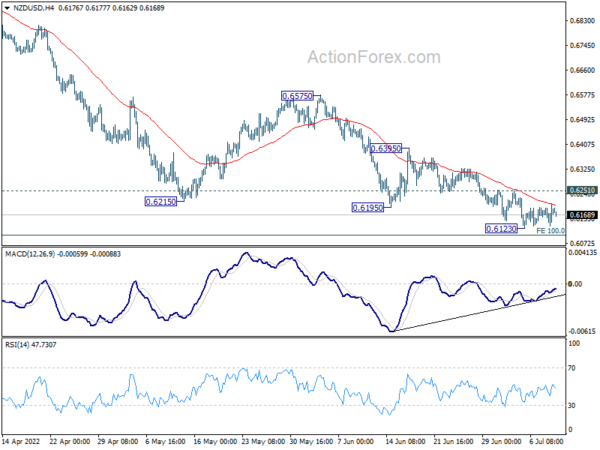
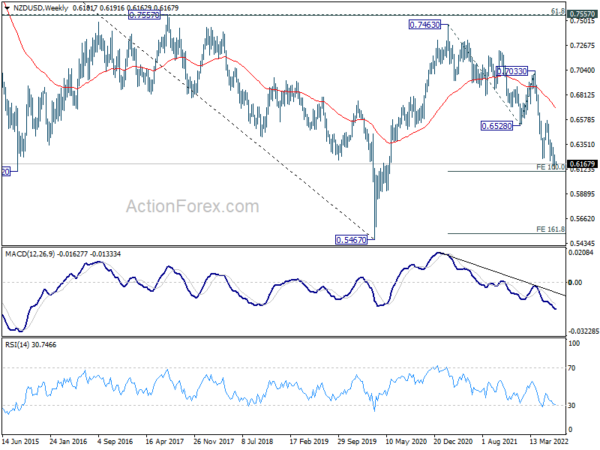
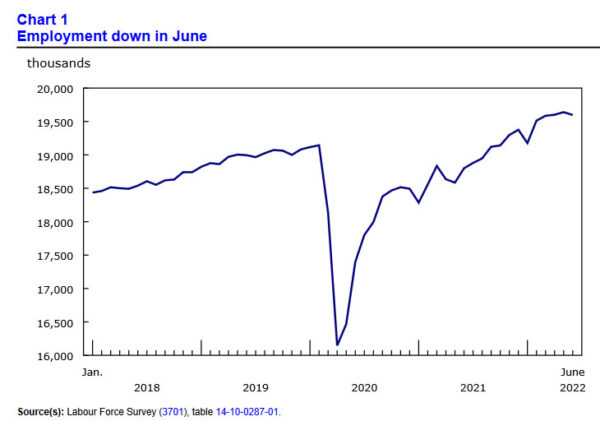
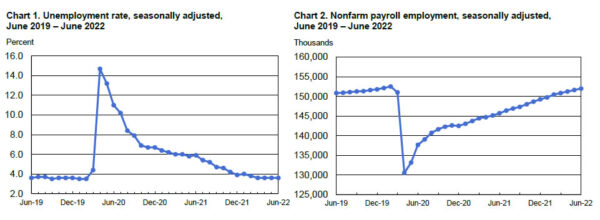
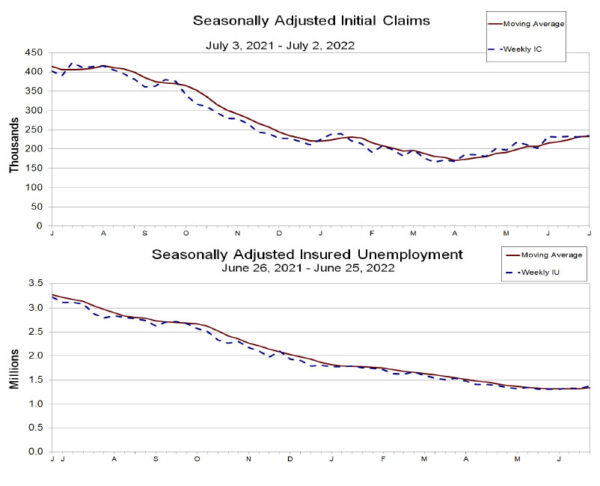
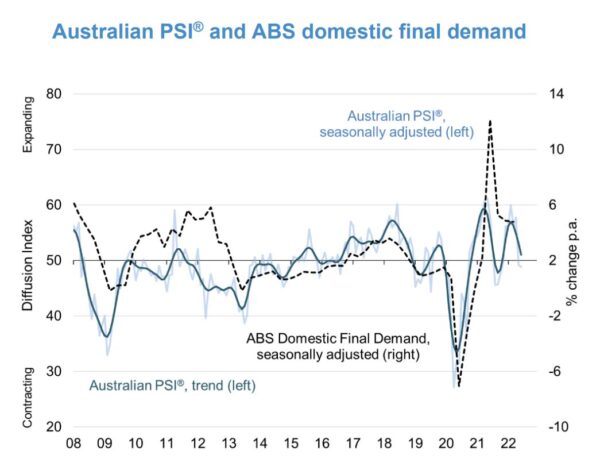
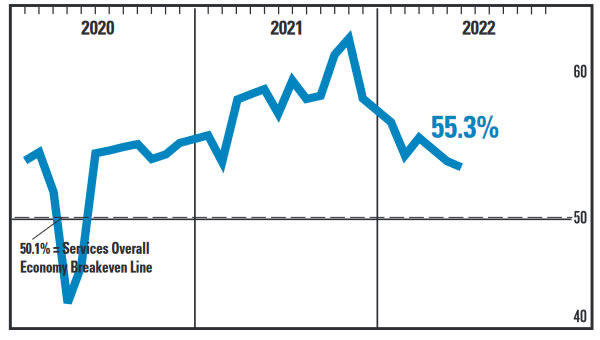
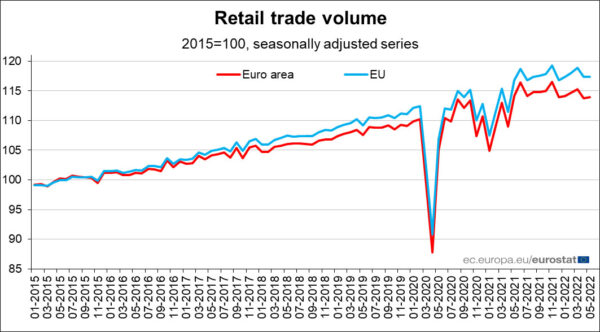
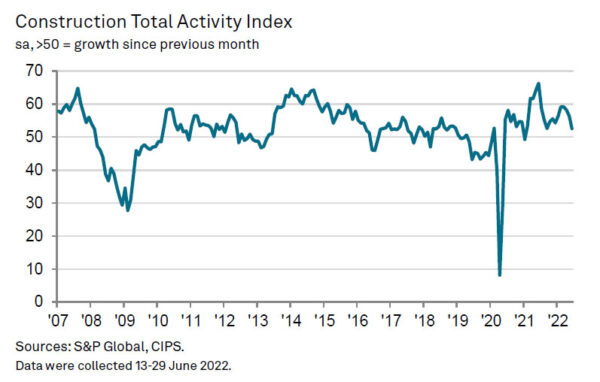
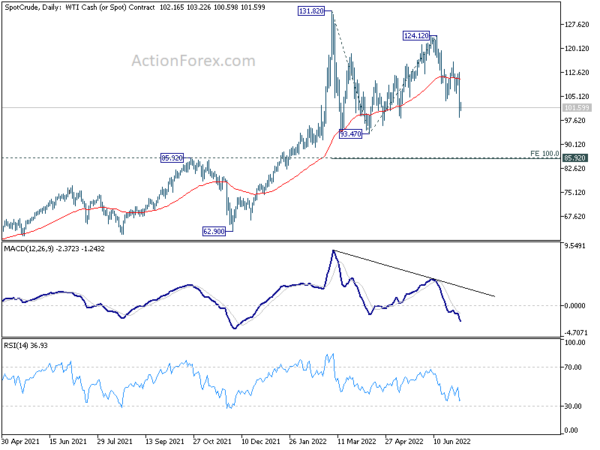
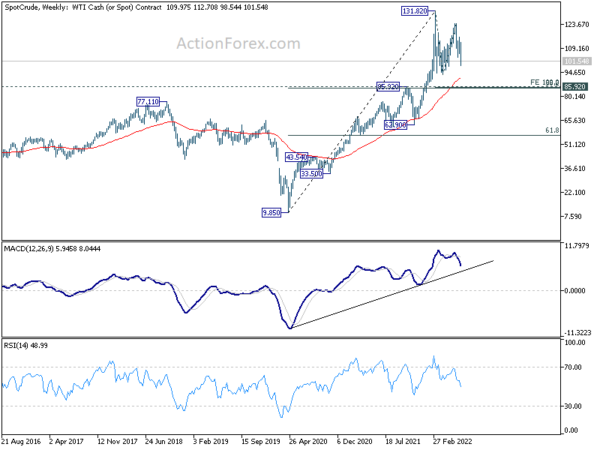
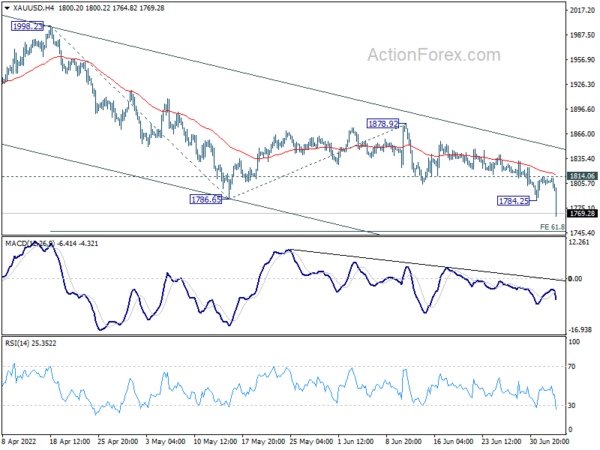
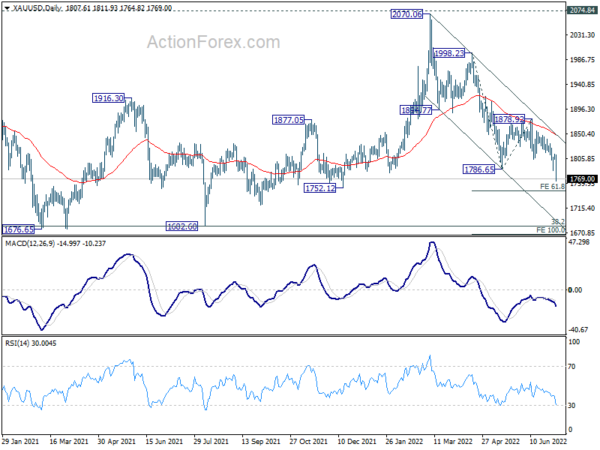
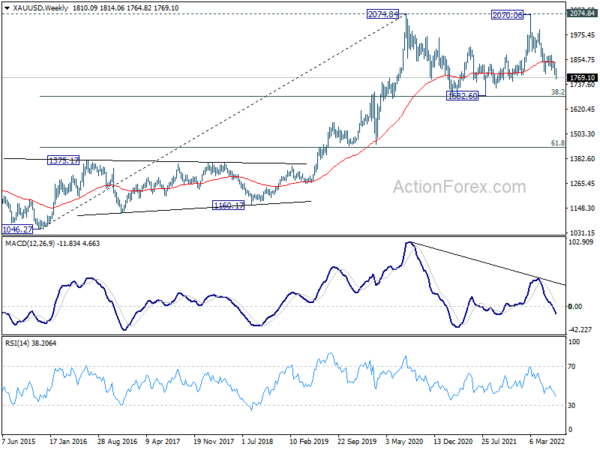

AUD/CAD staying in down trend, risks more downside
Canadian Dollar has been outperforming other commodity currencies recently and stays generally firm. There is prospect of further rally in the Loonie if BoC opts for a 75bps rate hike this week, instead of 50bps.
Looking at AUD/CAD, it’s staying well in the down trend from 0.9991 (2021 high). Outlook stays bearish as long as 0.8916 minor resistance holds. Break of 0.8744 temporary low will indicate down trend resumption. Next medium term target will be 100% projection of 0.9991 to 0.8906 from 0.9514 at 0.8429.
Nevertheless,firm break of 0.8916 will indicate short term bottoming and bring stronger rebound first.